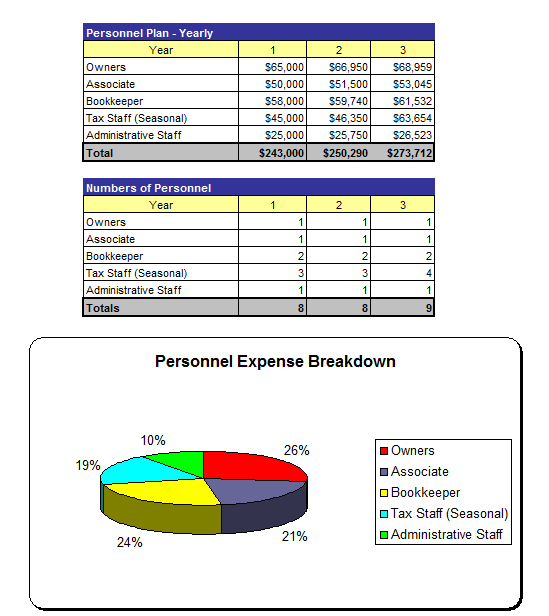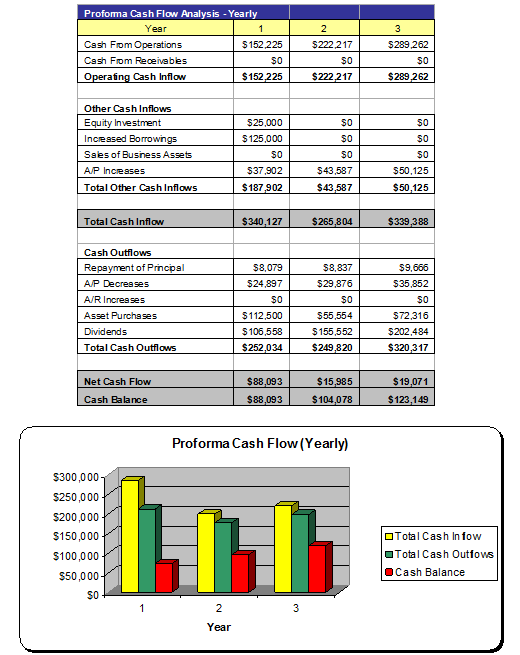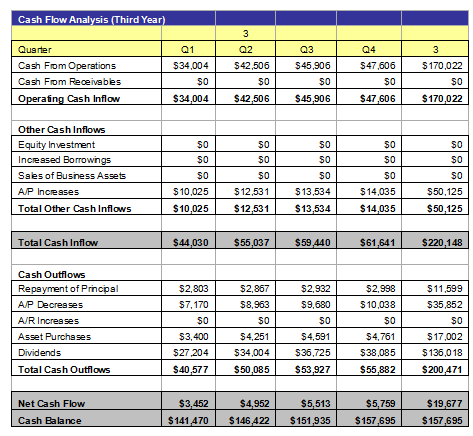Free Pawn Shop Business Plan
For Raising Capital from Investors, Banks, or Grant Companies!
Please note that the financials
in this complete free business plan are completely fictitious and may not
match the text of the business plan below. This free business plan demonstration
purposes only. If you are interested in purchasing the completed editable MS Word
and Excel documents for this business plan, please click the button below! Also,
the text of the business plan is formatted with a fully automated
table of contents.
Return to
Samples Page
It should be noted that there is no special software required to use these
templates. All business plans come in Microsoft Word and Microsoft Excel format.
Each business plan features:
- Excecutive Summary
- Company and Financing Summary
- Products and Services Overview
- Strategic Analysis with current research!
- Marketing Plan
- Personnel Plan
- 3 Year Advanced Financial Plan
- Expanded Financial Plan with Monthly Financials
- Loan Amortization and ROI Tools
- FREE PowerPoint Presentation for Banks, Investors,
or Grant Companies!
1.0 Executive Summary
The purpose of this business plan is to raise $100,000 for the development of a pawn shop while showcasing the expected financials and operations over the next three years. The Pawn Shop, Inc. (“the Company”) is a New York based corporation that will provide short term collateralized loans and sales of general merchandise inventories to customers in its targeted market. The Company was founded in 2009 by John Doe.
1.1 Products and Services
The Pawn Shop will act as a short term collateralized lender that will accept jewelry, electronics, certain musical instruments, and other objects of resalable value with the intent to provide a loan to the customer. These loans will typically be for a two week period and will carry a loan to collateral value ration of 25%. If, during the two week period, the customer does not come back in to pay the loan, the Company will then sell the merchandise to the general public. The Company anticipates a default rate of about 40% on the loans, which means that the business will generate a substantial portion of its income from the sale of customer inventories that have lapsed beyond the loan period. The Company will comply with all state and federal laws guiding the operation of pawn shops. The third section of the business plan will further describe the services offered by the Pawn Shop.
1.2 The Financing
Mr. Doe is seeking to raise $100,000 from as a bank loan. The interest rate and loan agreement are to be further discussed during negotiation. This business plan assumes that the business will receive a 10 year loan with a 9% fixed interest rate.
1.3 Mission Statement
The Pawn Shop’s mission is to become the recognized leader in its targeted market for small collateralized loan services.
1.4 Mangement Team
The Company was founded by John Doe. Mr. Doe has more than 10 years of experience in the retail management industry. Through his expertise, he will be able to bring the operations of the business to profitability within its first year of operations.
1.5 Sales Forecasts
Mr. Doe expects a strong rate of growth at the start of operations. Below are the expected financials over the next three years.

1.6 Expansion Plan
The Founder expects that the business will aggressively expand during the first three years of operation. Mr. Doe intends to implement marketing campaigns that will effectively target individuals within the target market.
2.0 Company and Financing Summary
2.1 Registered Name and Corporate Structure
Pawn Shop, Inc. The Company is registered as a corporation in the State of New York.
2.2 Required Funds
At this time, the Pawn Shop requires $100,000 of debt funds. Below is a breakdown of how these funds will be used:

2.3 Investor Equity
Mr. Doe is not seeking an investment from a third party at this time.
2.4 Management Equity
John Doe owns 100% of the Pawn Shop Shop, Inc.
2.5 Exit Strategy
If the business is very successful, Mr. Doe may seek to sell the business to a third party for a significant earnings multiple. Most likely, the Company will hire a qualified business broker to sell the business on behalf of the Pawn Shop. Based on historical numbers, the business could fetch a sales premium of up to 4 times earnings.
3.0 Products and Services
Below is a description of the collateralized loan and merchandise sales offered through the Pawn Shop.
3.1 Collateralized Loans
As stated in the executive summary, the Company will be actively engaged in pawn brokering. This means that customers can bring in an item of saleable value, such as a ring. If this ring is worth $500, the customer can receive a short term (usually two week) loan of $100 to $150. At the end of the two week period, the customer can repurchase the item back from the pawn shop for about $200 (assuming a $150 loan). During this time, the Pawn Shop will not sell the customer’s item to the general public. If the two week period lapses, and the customer does not come back in to acquire their merchandise then the Pawn Shop will sell this product to the general public. As the ring is worth $500, the Company will sell the ring for $400, to recoup the loss from the loan while generating a significant profit. As stated in the executive summary, at all times, the Company will operate within the framework of the law regarding the operation of its pawn shop and its lending operations.
3.2 Sales of Pawned Merchandise
The items that the Pawn Shop will accept for pawn brokering will include jewelry, precious metals/coins, certain electronics, certain musical instruments, and other items that can be readily be sold to the general public in the event that the customer defaults on the short term loan. The Company will earn gross margins of approximately 60% on all items sold by the Pawn Shop.
4.0 Strategic and Market Analysis
4.1 Economic Outlook
This section of the analysis will detail the economic climate, the pawn brokering industry, the customer profile, and the competition that the business will face as it progresses through its business operations. Currently, the economic market condition in the United States is in recession. This slowdown in the economy has also greatly impacted real estate sales, which has halted to historical lows. Many economists expect that this recession will continue until mid-2009, at which point the economy will begin a prolonged recovery period. However, Pawn Shops typically are immune from negative changes in the economy as people strapped for money (especially during times of economic recession) will use the shop more often. The only concern for the Pawn Shop is that during times of economic duress, fewer people may purchase merchandise acquired from defaulted loans.
4.2 Industry Analysis
Within the United States, there are approximately 18,000 companies that operate in a pawn brokering capacity. Each year, these retailers/lenders generate more than $6 billion of revenue while providing jobs to more than 100,000 people. Aggregate payrolls in each of the last five years have exceeded $1.2 billion. This is a mature industry, and the expected future growth rate of sales receipts is expected to remain in lockstep with the general economy. As discussed above, the business may actually see a slight increase in its lending portfolios and inventory holdings as deleterious economic conditions often lead to more people using pawn brokering businesses to quickly sell merchandise. Again, the concern here is that sales of merchandise that has come under ownership due to default will slow.
4.3 Customer Profile
In this section of the analysis, you should describe the type of customer you are seeking to acquire. These traits include income size, type of business/occupation; how far away from your business is to your customer, and what the customer is looking for. In this section, you can also put demographic information about your target market including population size, income demographics, level of education, etc.
4.4 Competitive Analysis
This is one of the sections of the business plan that you must write completely on your own. The key to writing a strong competitive analysis is that you do your research on the local competition. Find out who your competitors are by searching online directories and searching in your local Yellow Pages. If there are a number of competitors in the same industry (meaning that it is not feasible to describe each one) then showcase the number of businesses that compete with you, and why your business will provide customers with service/products that are of better quality or less expensive than your competition.
5.0 Marketing Plan
The Pawn Shop intends to maintain an extensive marketing campaign that will ensure maximum visibility for the business in its targeted market. Below is an overview of the marketing strategies and objectives of the Pawn Shop.
5.1 Marketing Objectives
-
• Develop an online presence by developing a website and placing the Company’s name and contact information with online directories.
-
• Implement a local campaign with the Company’s targeted market via the use of flyers, local newspaper advertisements, and word of mouth.
-
5.2 Marketing Strategies
Mr. Doe intends on using a number of marketing strategies that will allow the Pawn Shop to easily target men and women within the target market. These strategies include traditional print advertisements and ads placed on search engines on the Internet. Below is a description of how the business intends to market its services to the general public. The Pawn Shop will also use an internet based strategy. This is very important as many people seeking local services, such as pawn brokers, now the Internet to conduct their preliminary searches. Mr. Doe will register the Pawn Shop with online portals so that potential customers can easily reach the business. The Company will also develop its own online website showcasing the Company’s location, hours of operation, store policies, and what items are considered acceptable as collateral. The Company will maintain a sizable amount of print and traditional advertising methods within local markets to promote the pawn brokering services and general merchandise products that the Company is selling.
5.3 Pricing
In this section, describe the pricing of your services and products. You should provide as much information as possible about your pricing as possible in this section. However, if you have hundreds of items, condense your product list categorically. This section of the business plan should not span more than 1 page.
6.0 Organizational Plan and Personnel Summary
6.1 Corporate Organization

6.2 Organizational Budget

6.3 Management Biographies
In this section of the business plan, you should write a two to four paragraph biography
about your work experience, your education, and your skill set. For each owner or
key employee, you should provide a brief biography in this section.
7.0 Financial Plan
7.1 Underlying Assumptions
-
• The Pawn Shop will have an annual revenue growth rate of 16% per year.
-
• The Owner will acquire $100,000 of debt funds to develop the business.
-
• The loan will have a 10 year term with a 9% interest rate.
7.2 Sensitivity Analysis
In the event of an economic downturn, the business may have a decline in its revenues. As discussed earlier, during times of economic waning, the Pawn Shop may see an increase in its inventories and a subsequent increase in the number of defaulted collateralized loans it provides. However, the very high gross margins of the business will ensure that the Company remains profitable during difficult economic climates.
7.3 Source of Funds

7.4 General Assumptions

7.5 Profit and Loss Statements

7.6 Cash Flow Analysis

7.7 Balance Sheet
 .
.
7.8 General Assumptions

7.9 Business Ratios

Expanded Profit and Loss Statements




Expanded Cash Flow Analysis



